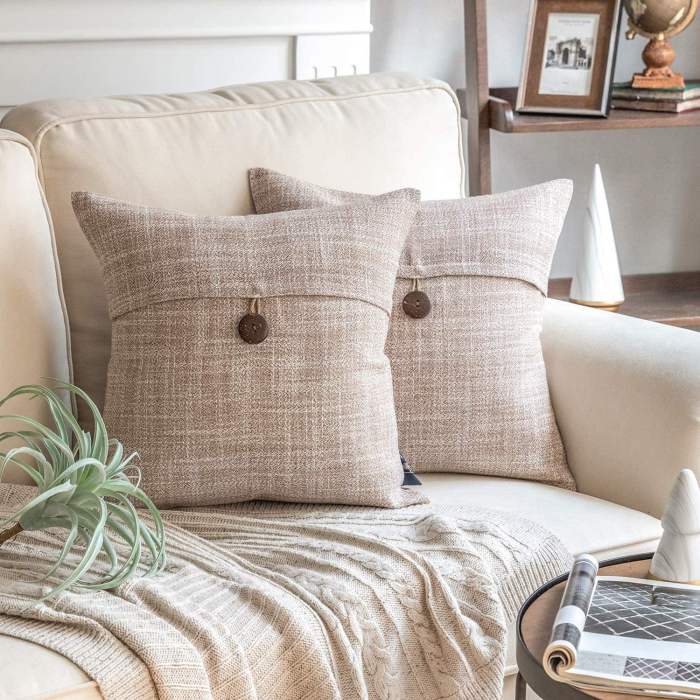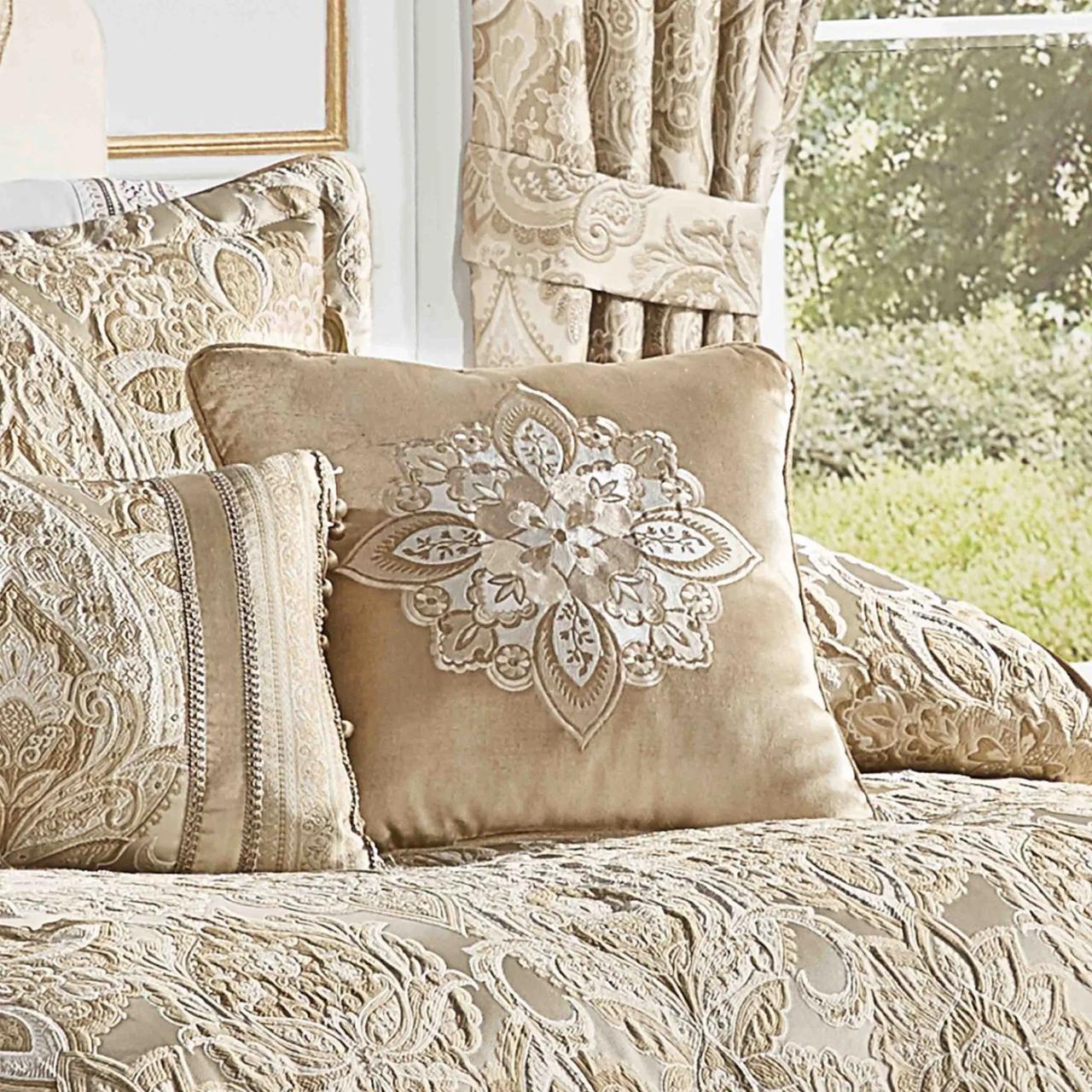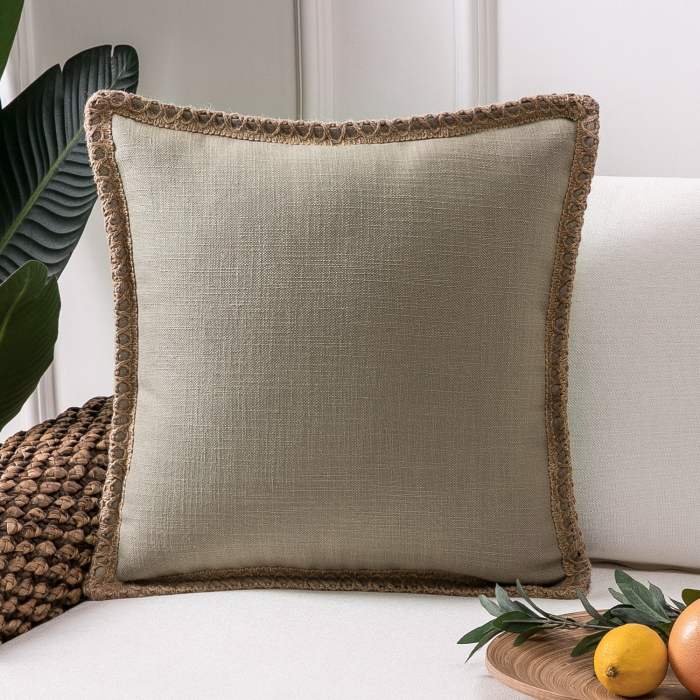Beige Decorative Pillows: More than just a neutral hue, beige pillows offer unparalleled versatility in interior design. From subtle sophistication to bold textural contrasts, beige’s adaptability allows it to seamlessly integrate into diverse aesthetics, complementing everything from minimalist modern spaces to cozy bohemian retreats. This guide delves into the world of beige decorative pillows, exploring market trends, design aesthetics, manufacturing processes, and effective sales strategies to help you understand this popular home décor item.
We’ll examine the various materials used, from luxurious velvet to sustainable linen, and compare different filling options to ensure durability and comfort. We’ll also explore effective marketing techniques, customer feedback analysis, and competitive landscapes to provide a comprehensive overview of this thriving market segment. Whether you’re a consumer seeking the perfect pillow or a business looking to capitalize on this trend, this guide offers invaluable insights.
Design and Aesthetics of Beige Pillows

Beige, a versatile neutral, transcends fleeting trends in interior design. Its understated elegance allows it to seamlessly integrate into a wide array of styles, from minimalist modern to classic traditional, creating a foundation upon which bolder colors and textures can be layered. The inherent calmness of beige promotes relaxation and sophistication, making it a popular choice for spaces where comfort and style are paramount.Beige decorative pillows offer a remarkable range of design possibilities, far exceeding the perception of a simple, monotonous color.
The subtle variations in shade, combined with diverse textures and patterns, allow for a rich tapestry of visual interest within any room.
Beige Pillow Textures and Patterns
The beauty of beige pillows lies not only in their color but also in the tactile experience they offer. A diverse selection of fabrics contributes to this versatility. Linen, for example, brings a natural, slightly textured feel, ideal for creating a relaxed, rustic atmosphere. Velvet, on the other hand, introduces a luxurious softness and opulent sheen, perfect for adding a touch of glamour.
Other popular choices include cotton, for its breathability and ease of care; bouclé, with its unique looped texture; and faux fur, for a cozy and inviting ambiance. Beyond the base fabric, patterns add another layer of complexity. Subtle embroidered details can elevate a plain pillow to a statement piece, while geometric prints or floral motifs can inject personality and visual interest.
Beige Pillow Designs for Different Rooms
The adaptability of beige allows for the creation of unique pillow designs tailored to specific room settings.
Living Room: Imagine a large, square linen pillow in a warm, sandy beige. Its simple, unadorned surface provides a grounding element for a living room decorated in vibrant colors or bold patterns. The natural texture of the linen complements wooden furniture and adds a touch of rustic charm. Paired with a smaller, textured velvet pillow in a slightly darker beige shade, this creates a sophisticated yet comfortable seating arrangement.
Bedroom: For a serene bedroom, consider a pair of rectangular pillows in a pale, creamy beige. These could be made from a soft, plush cotton with subtle embroidered floral details in a coordinating neutral shade, creating a calming and romantic atmosphere. The subtle pattern adds visual interest without overwhelming the space, contributing to a sense of tranquility. The soft texture invites relaxation and complements a minimalist or bohemian aesthetic.
Office: A sophisticated office space could benefit from a pair of smaller, square pillows in a sophisticated taupe beige. These could be crafted from a durable bouclé fabric, offering both visual appeal and comfortable support for extended periods of sitting. The texture adds a touch of visual interest without detracting from the professional atmosphere. The neutral color complements most office décor styles, from contemporary to traditional.
Manufacturing and Materials
The production of beige decorative pillows involves a careful selection of materials, impacting both the aesthetic appeal and the longevity of the final product. The choice of fabric, filling, and construction methods significantly influence the pillow’s comfort, durability, and overall cost. Understanding these factors is crucial for manufacturers and consumers alike.The creation of a beige decorative pillow begins with the selection of the outer fabric.
This is often a crucial factor determining the pillow’s overall look and feel. Various fabrics, each with its own advantages and disadvantages, contribute to the final product’s characteristics.
Fabric Selection for Beige Decorative Pillows
Fabric selection directly impacts the pillow’s texture, drape, and durability. Common choices include cotton, linen, velvet, and microfiber. Cotton offers breathability and softness, while linen provides a more rustic and textured appearance. Velvet adds a luxurious touch with its smooth, plush surface, and microfiber offers a budget-friendly option with its easy care and stain resistance. However, cotton can wrinkle easily, linen can be prone to fading, velvet requires careful cleaning, and microfiber may not be as breathable as natural fibers.
The choice depends on the desired aesthetic and practical considerations.
Pillow Filling Materials: A Comparison of Durability and Longevity
The filling material significantly influences a pillow’s comfort, support, and lifespan. Feather and down fillings provide a luxurious, fluffy feel, conforming to the user’s head and neck. However, these natural fillings require more care and may not be suitable for allergy sufferers. They can also lose their loft over time, requiring more frequent fluffing. Foam fillings, on the other hand, offer more structured support and are generally more durable and hypoallergenic.
Different foam densities provide varying levels of firmness and support. Polyester fiberfill is a budget-friendly alternative, offering good resilience but potentially lacking the luxurious feel of feather or down. The longevity of each filling varies greatly, with foam typically lasting longer than feather or down, provided it doesn’t break down due to age or poor quality.
Sustainable and Eco-Friendly Materials for Beige Decorative Pillows
Choosing sustainable materials is increasingly important for environmentally conscious consumers. Several options exist for creating eco-friendly beige decorative pillows.
- Organic Cotton: Grown without harmful pesticides and fertilizers, organic cotton is a more sustainable alternative to conventionally grown cotton.
- Recycled Polyester: Made from recycled plastic bottles, this material reduces landfill waste and lowers the environmental impact of production.
- Tencel (Lyocell): A sustainable fiber derived from eucalyptus trees, Tencel is known for its softness, breathability, and low environmental impact.
- Hemp: A durable and naturally pest-resistant fiber, hemp requires less water and pesticides than cotton.
- Kapok: A natural fiber filling alternative to down, kapok is lightweight, hypoallergenic, and sustainably harvested.
Retail and Sales Strategies

Selling beige decorative pillows requires a multi-faceted approach leveraging both online and offline channels to reach a broad customer base. A successful strategy emphasizes the versatility and timeless appeal of beige, positioning it not as a bland color but as a sophisticated neutral that complements various interior styles.Effective marketing hinges on showcasing the pillows’ ability to enhance different design aesthetics, from minimalist modern to cozy traditional settings.
Highlighting the high-quality materials and craftsmanship further strengthens the value proposition.
Online Marketing Strategies
Online marketing for beige decorative pillows should focus on visually appealing content that showcases the product’s versatility and quality. High-resolution photography and videography are essential, demonstrating how the pillows look in different room settings and with varying furniture styles. Utilizing platforms like Instagram, Pinterest, and Facebook, known for their strong visual focus, is crucial. Targeted advertising campaigns on these platforms, focusing on demographics interested in home décor and interior design, can drive significant traffic to an e-commerce website.
Influencer marketing, partnering with home décor bloggers or interior designers, can provide authentic product endorsements and reach a wider audience. Search engine optimization () is also vital, ensuring the website and product listings rank highly for relevant s like “beige throw pillows,” “neutral decorative pillows,” and “luxury home décor.” Finally, email marketing campaigns can nurture leads and promote special offers.
Offline Marketing Strategies
Offline marketing strategies should complement online efforts, creating a cohesive brand experience. Participating in home décor shows and craft fairs allows for direct interaction with potential customers, showcasing the pillows’ texture and quality firsthand. Collaborations with interior design firms or furniture stores can expose the pillows to a curated customer base already interested in high-quality home furnishings. Print advertising in relevant magazines or newspapers can reach a more mature audience interested in traditional media.
Strategic partnerships with local businesses, such as coffee shops or boutiques, can provide additional exposure through in-store displays or cross-promotional activities.
Promotional Campaign: “Beige Reimagined”
A promotional campaign titled “Beige Reimagined” could highlight the versatility of beige pillows. The campaign would feature high-quality photography and videography showcasing the pillows in various interior styles, from minimalist Scandinavian to classic Victorian. The campaign messaging would emphasize the timeless elegance and sophisticated simplicity of beige, positioning it as a neutral that enhances rather than detracts from other design elements.
Social media contests and giveaways could further engage customers and build brand awareness. The campaign could also incorporate testimonials from satisfied customers, showcasing the pillows’ comfort and durability. Limited-time offers and discounts could incentivize purchases.
Branding and Packaging Strategies
Successful branding for beige decorative pillows requires a sophisticated and minimalist aesthetic, reflecting the product’s quality and timeless appeal. The brand name and logo should be elegant and memorable, conveying a sense of luxury and sophistication. High-quality packaging, such as a custom-designed box with a subtle yet elegant design, enhances the perceived value of the pillows. Including a personalized thank-you note or a small gift, such as a scented sachet, can create a positive unboxing experience and foster customer loyalty.
Consistent branding across all platforms, from the website to social media to packaging, reinforces brand recognition and builds a strong brand identity. For example, a brand might use a muted color palette on its website and packaging, reflecting the calming nature of beige. The use of high-quality materials in the packaging, such as recycled paper or organic cotton, can align the brand with environmentally conscious values.
Styling and Interior Design: Beige Decorative Pillows

Beige decorative pillows offer unparalleled versatility, seamlessly integrating into a wide range of interior design styles. Their neutral tone acts as a blank canvas, allowing them to complement bolder choices or subtly enhance a minimalist aesthetic. Understanding how to incorporate them effectively can elevate the overall look and feel of any space.Beige’s inherent adaptability stems from its ability to function as both a background and a highlight, depending on its application and surrounding elements.
Its calming nature makes it suitable for spaces prioritizing relaxation and tranquility, while its subtle sophistication prevents it from feeling bland or uninteresting. Strategic placement and thoughtful pairing with other colors and textures are key to maximizing its potential.
Beige Pillows in Different Interior Design Schemes
Beige pillows readily adapt to various design styles. In minimalist interiors, their understated elegance contributes to the clean lines and uncluttered aesthetic. Imagine a crisp white sofa accented by two or three square beige pillows, possibly with a subtle texture like linen. The absence of competing colors allows the simplicity of the design to shine. Conversely, in a bohemian setting, the same beige pillows could be paired with richly patterned throws, vibrant colored cushions, and natural fiber rugs.
The beige provides a grounding element, preventing the space from feeling chaotic while still contributing to the eclectic feel. In traditional interiors, beige pillows, perhaps in a heavier fabric like velvet or damask, add a touch of understated luxury, complementing antique furniture and ornate details. The neutral tone prevents the space from feeling overly busy while enhancing the overall elegance.
Creating Visually Appealing Arrangements of Beige Pillows, Beige Decorative Pillows
The arrangement of pillows significantly impacts the overall visual appeal. A sofa or bed shouldn’t be overcrowded; instead, aim for a balanced and aesthetically pleasing arrangement. Consider varying sizes and textures of pillows to add visual interest. For example, a large, square beige linen pillow could be paired with a smaller, rectangular velvet beige pillow. Playing with layering is also important; larger pillows form the base, with smaller, decorative pillows placed on top.
Avoid using too many different patterns or textures, as this can create a cluttered look. A cohesive and balanced arrangement conveys a sense of calm and sophistication. The number of pillows should also be proportional to the size of the furniture; a small loveseat will look overwhelmed with too many pillows, while a large sectional could easily accommodate a more extensive arrangement.
Choosing Complementary Colors and Patterns to Pair with Beige Pillows
The beauty of beige lies in its compatibility with a vast color palette.
- Muted Jewel Tones: Deep teal, emerald green, or sapphire blue create a sophisticated and calming contrast against beige. These colors add depth and visual interest without overpowering the neutral base.
- Earthy Tones: Warm browns, terracotta, and mustard yellow complement beige’s natural feel, creating a cozy and inviting atmosphere. These colors work especially well in spaces designed to evoke a sense of warmth and comfort.
- Bright Accents: Pops of bright color, such as coral, turquoise, or sunny yellow, can be used sparingly to add energy and vibrancy to a predominantly beige space. These accents should be used strategically to prevent the space from feeling overwhelming.
- Neutral Variations: Pairing beige pillows with other neutral tones, such as gray, cream, or ivory, creates a cohesive and calming palette. This approach is ideal for minimalist or Scandinavian design schemes.
- Geometric Patterns: Simple geometric patterns in colors that complement the beige, such as navy, charcoal, or blush pink, can add visual interest without being overwhelming. These patterns should be chosen to complement the overall style of the room.
Ultimately, the enduring appeal of beige decorative pillows lies in their adaptability and timeless elegance. By understanding market trends, design aesthetics, and effective sales strategies, both consumers and businesses can harness the power of this versatile color to create stylish and comfortable living spaces. This guide has provided a comprehensive overview, equipping you with the knowledge to navigate the world of beige decorative pillows with confidence, whether you’re selecting the perfect complement to your existing décor or developing a successful product line.